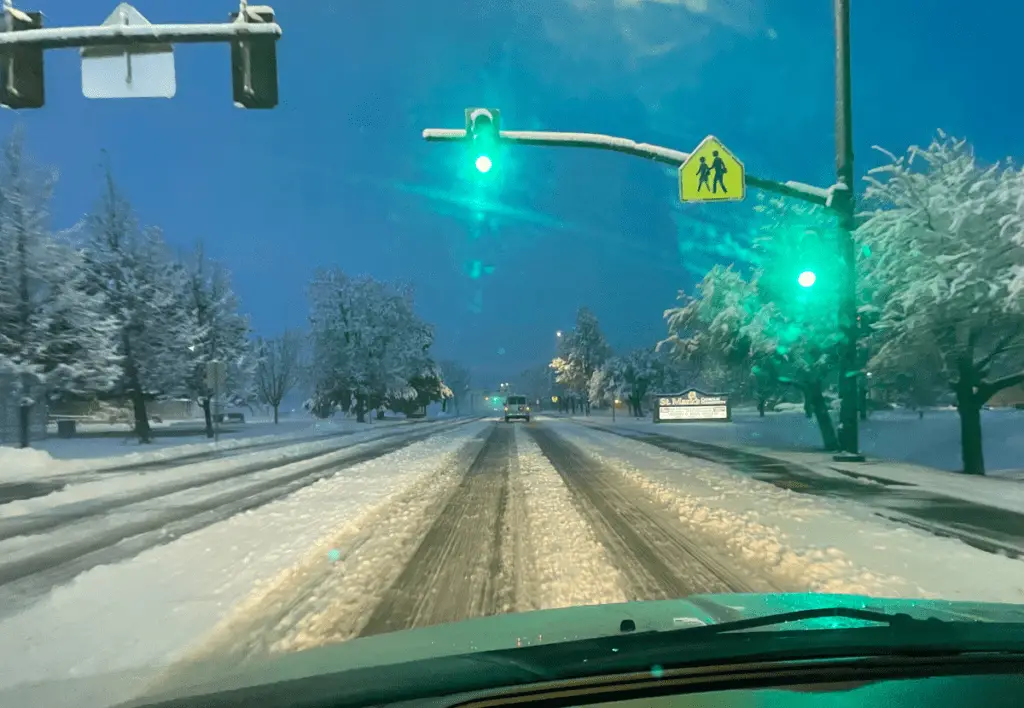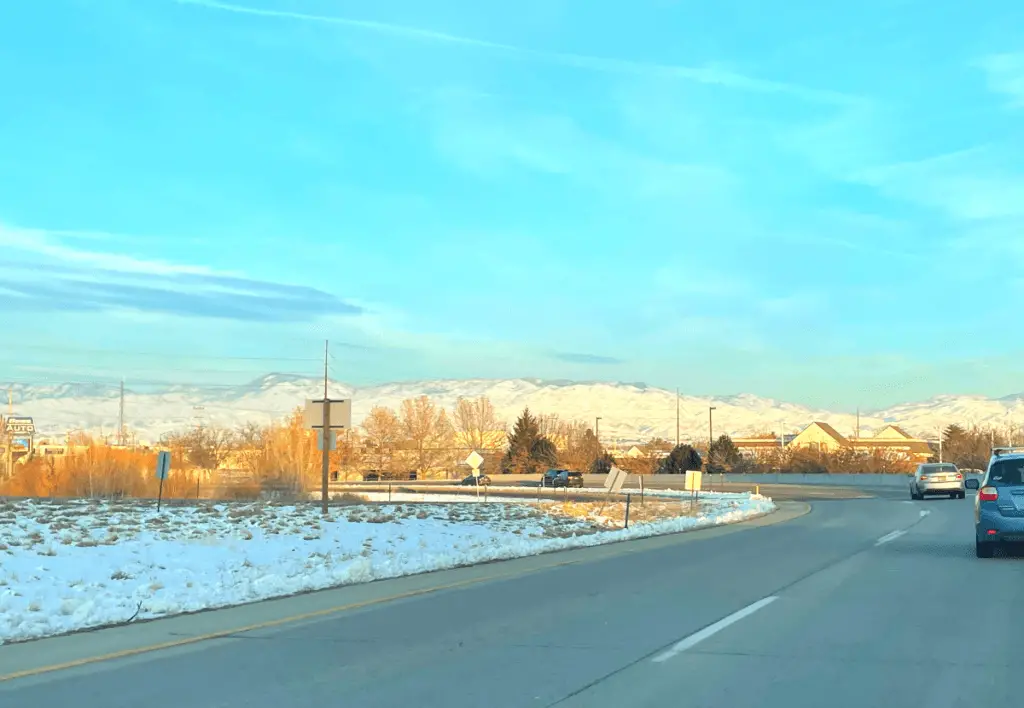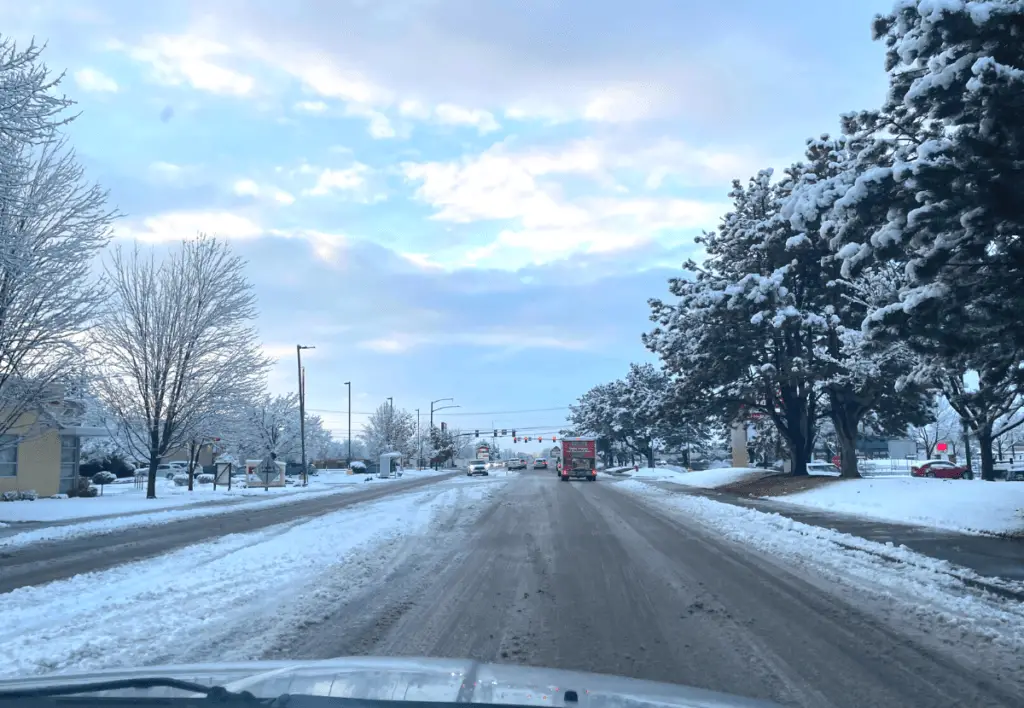Whether you recently moved to Boise, your thinking about moving, or just passing through, it’s important to know how to prepare yourself and your vehicle for the winter weather. If you’re not prepared you could get stuck or end up in an accident.
I have over a decade of experience driving in Boise’s winters. So in this article, I’m going to teach you what to expect and how to best prepare for the city’s winter driving conditions.
How to Prepare for Winter Driving In Boise

Ensuring you and your vehicle are ready to take on Boise’s winter is important for your safety and peace of mind. Below is exactly how I prepare for winter every year as a local.
Get snow tires or all seasons
You should get a dedicated set of snow tires or all seasons for Boise winters. Driving in the winter with bald or worn-out tires is difficult. Chains or studded tires aren’t necessary as the snow isn’t severe enough. However, you should keep chains in your vehicle for emergencies.
It’s best to put your winter tires on the first week of November as that’s when snow usually begins to fall in Boise. By the end of February to early March, you can take your winter tires off as the temperature increases and the snow melts quickly.
The type of tire you get really depends on the type of vehicle you drive and your experience driving in the snow. If you have a rear-wheel drive vehicle, I recommend getting studless snow tires for extra traction.
If you don’t have experience driving in the snow then I’d still recommend getting a good set of snow tires over all seasons, as they provide better traction and handling on icy roads.
Nevertheless, if you have an all-wheel drive vehicle or front-wheel drive you can get away with using a new set of all seasons. Again, if you lack winter driving experience I still recommend snow tires even if you have a more “winter-capable” vehicle.
Personally, I’ve used both in my front-wheel drive car with minimal issues. I used to drive to Oregon for work every day through the snowy mountains, and I did fine using all seasons.
Regardless of which tires you choose to use, make sure each season they still have enough tread to be effective. All seasons only last 1-2 years if you use them year-round.
Ensure you have the proper tools in your vehicle
You never know what could happen when you’re out on the road. That’s why it’s essential to carry anything you might need with you, even if you’re just driving to work.
Here are the items I carry in my vehicle at all times during the winter:
- Ice scraper. You’ll need a good ice-scraper if you plan on seeing the road while you drive. With Boise’s bipolar weather, it can snow at any time throughout the day. Having an ice scraper ready to go is essential. I don’t leave home without one.
- Snow shovel. A portable snow shovel is always nice to have in case too much snow builds up around your car or you get stuck. You’ll need a way to clear a path. Get a shovel. I recommend this ice scraper and portable snow shovel combo on Amazon.
- Kitty litter and rock salt. To accompany your snow shovel, a bag of kitty litter and rock salt can help you get out of even the slickest situations. After shoveling, simply throw down a mixture of the two near your wheels for an added layer of traction.
- Snow chains. Although snow chains are overkill for everyday winter driving in Boise, it’s crucial to have a pair in your vehicle for emergencies. Just remember, you can only drive about 30 mph with chains on. Go slow.
- Flashlight. A flashlight is something you should have in your vehicle at all times, not just in the winter. I can’t count the times I’ve had to pull over to check something on my car. It’d have been impossible without a flashlight. I got this super bright two-pack for me and my wife.
- Reflective triangles. Just like a flashlight, reflective triangles are something you should always carry with you. They increase your visibility which not only helps keep you safe but helps others stay safe as well. For less than $20, reflective triangles are more than worth it.
- Jumper cables. Another essential item no matter the time of year are jumper cables. If you don’t end up needing them, more than likely someone else will. Better yet, I prefer a portable jump starter. That way you don’t have to rely on another vehicle to jumpstart your car in a pinch.
- Phone charger. Come on, does anyone actually drive without their phone charger? I don’t think so. But if you’re the 1% who doesn’t carry a phone charger with you, you’d better start. You never know when there’ll be an emergency.
- Sleeping bag. Maybe it’s the Idahoan in me, but I think a sleeping bag is an essential item you should always store in your vehicle—especially in the winter. You have to prepare for the worst. You don’t need anything fancy, just a simple 0-degree sleeping bag will suffice.
I know, that’s a lot of things to carry in your vehicle. But to be fair, I didn’t always have these items in my car. My experiences driving in the winter have led me to obtain all these items over the course of 10 years.
If I had to narrow it down to three things I’d say the ice scraper, battery jumper, and reflective triangles are an absolute must.
How to Drive Safely During the Winter in Boise

Now that you and your vehicle are all set, it’s time for some actionable driving tips to help you keep safe on Boise’s winter roads. Here are my best tips.
Perform a safety check at the beginning of winter
At least once during the winter season, preferably at the beginning, you should do a complete safety check to ensure your vehicle is functioning as it should. Here is what I check personally.
- Lights. Hi-beams, low-beams, fog lights, brake lights, and front and rear blinkers.
- Windshield washer fluid. Ensure your fluid is full on the cap is on tight.
- Wiper blades. If your windshield wipers lack rubber, leave streaks, or make a chattering sound when turned on, it might be time to change them.
If you prefer someone else checks out your vehicle for you, take it to a nearby mechanic and they’ll probably do it for free.
Better yet, when you get your winter tires put on ask the shop to do a safety check as there are other things that could be checked as well (serpentine belt, other fluids, air filter, tire pressure).
Just don’t let them charge you for blinker fluid… I heard it doesn’t work.
Give yourself extra time to get places
During the winter traffic moves slower and there are more accidents, which means it’s going to take you extra long to get anywhere. This isn’t always the case, but it usually is on a snowy day.
So, whether you’re leaving to work, headed to a meeting, going to a doctor’s appointment, or meeting your friend for coffee, make sure to give yourself extra time to get there.
A good general rule of thumb is multiplying the time it would normally take to get somewhere by 1.5. Hence, if it takes you 20 minutes to drive to work you should give yourself at least 30 minutes on a snowy day (20 minutes x 1.5 = 30 minutes).
For extreme road conditions, you might want to even double the time it usually takes.
Ensure your vehicle is clear of snow before driving
This is where your handy ice-scraper tool comes into play. If you park your car outside you’ll need to brush off all the snow and scrape your windows. Leaving snow on your vehicle is dangerous as it could impair your or someone else’s vision while driving when it blows off.
Likewise, driving before you’ve gotten all the ice off your windows is a huge hazard. Make sure you can see clearly out of all your windows (including your blind spots) before driving.
Slow down, especially on the freeway
The reason you give yourself more time to get to wherever you’re going is so that you can drive slowly and safely.
This is especially true on the freeway. The speed limit on the freeway in town is 65 mph. If it’s covered with snow and ice, most people will drive about 30 to 40 mph just to be safe.
Generally, the freeway is where the snow plows will head first. But, even if the snow plows have already cleared the road there could still be black ice and piles of snow to the right and left of the freeway.
It’s best to drive slowly to ensure you have time to react in case something does happen. This includes the backroads where there are numerous intersections and pedestrians.
Remember, when it snows it takes longer to speed up, longer to stop, and it’s slower to make turns. Just relax, and drive slowly.
Avoid using cruise control
I don’t know about you, but I’m a big fan of using cruise control. Probably because I got too many speeding tickets in my younger years, and it helps me keep my lead foot off the gas pedal.
That said, using cruise control when there’s snow and ice on the road is a bad idea. If your car skids and you have cruise control on, it will still attempt to accelerate. If this happens you’re likely to lose control and slide into the cement barriers or other vehicles on the road.
I see this happen every winter and I can only assume it’s a combination of using cruise control and excessive speed for the conditions.
Avoid the left lane
I always try to avoid the left lane on the freeway when there’s snow on the road. I’m assuming since there’s always fresh snow and ice on the shoulder, vehicles get pulled into it and up crashing into the concrete barrier as a result.
The middle lanes, however, are usually in better condition assuming the snow plows have already treated the roads. If the snow plows haven’t treated the streets though, all the lanes are pretty much the same.
If you get stuck stay in your vehicle
More than likely you’re bound to get stuck at least once while driving in the snow. If this happens to you on the main roadway make sure to stay in your vehicle with your hazards on and call for help.
Getting out of your vehicle is extremely dangerous so it’s best to avoid doing so at all costs.
The one exception is if you get stuck in your neighborhood or an empty backstreet. If you’ve got a snow shovel in your car, you can use it to dig your way out and clear a path to get unstuck.
If that doesn’t work, open up your bag of kitty litter and rocksalt and dump it as close to your tires as possible. You can use your shovel to wedge some under your wheels too.
Make sure to dump it around the wheels which power your vehicle (ie if your car is fwd dump it around both front wheels for increased traction).
I’ve only gotten stuck twice in all my years of driving. Both times were in my neighborhood as I was pulling out of my driveway. To avoid this, simply reverse a little quicker than usual so your wheels don’t end up in the gutter where you’re most likely to get stuck.
Always wear your seatbelt
Not only is it Idaho law to wear your seatbelt, but it’s also the right thing to do. According to The National Highway Traffic Safety Administration (NHTSA), seatbelts reduce the risk of fatalities in the front seat of a car by 45% and moderate to critical injuries by 50%.
Boise is known for its bad drivers so believe me when I say you should wear it—especially in the winter. A report from the Idaho Transportation Department stated there were over 5,000 wrecks in Idaho between January and April alone, some of which were fatal.
Does Boise Use Salt on Roads in the Winter?

Boise uses a combination of snow plows and salt to eliminate heavy snow and ice on the roadways. Plow vehicles will spray a liquid de-icer called “ice slicer” in lower temperatures to keep the roads clear. On backroads, a heavy layer of sand may be applied as opposed to salt or plowing.
On certain streets, sand is only applied to roundabouts and at intersections with stop signs. In some instances, roads such as neighborhoods and less busy backstreets will receive no treatment at all. This is where you’re most likely to get stuck.
Overall, driving in Boise during the winter is really not too bad. Plus, half the things I mentioned in this article likely aren’t even conducted by locals. So assuming you follow at least some of the things I mentioned you’ll be in good shape for the snowy season.
If you’re looking to learn more about Boise from a local resident (me), make sure to check these other articles.
- What Is It Like to Live In Boise? (A Local’s Perspective)
- 20 Pros and Cons of Living in Boise (Composed By A Local)
- Is Boise A Big City? (An In-Depth Vibe Check)
